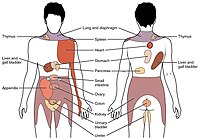
Photo from wikipedia
Purpose Everyday variations in night sleep in healthy pain-free subjects are at most weakly associated with pain, whereas strong alterations (eg, sleep deprivation, insomnia) lead to hyperalgesic pain changes. Since… Click to show full abstract
Purpose Everyday variations in night sleep in healthy pain-free subjects are at most weakly associated with pain, whereas strong alterations (eg, sleep deprivation, insomnia) lead to hyperalgesic pain changes. Since it remains unclear how substantial sleep alterations need to be in order to affect the pain system and lead to a coupling of both functions, the present study aimed at providing sufficient variance for co-variance analyses by examining a sample consisting of both healthy subjects and chronic pain patients. Methods A sample of 20 chronic musculoskeletal pain patients and 20 healthy controls was examined. This sample was assumed to show high inter-individual variability in sleep and pain, as pain patients frequently report sleep disturbances, whereas healthy subjects were required to be pain-free and normal sleepers. Sleep of two non-consecutive nights was measured using portable polysomnography and questionnaires. Experimental pain parameters (pressure pain thresholds (PPT), temporal summation of pain (TSP), conditioned pain modulation (CPM)) and situational pain catastrophizing (SCQ) were assessed in laboratory sessions before and after sleep. Pain patients’ clinical pain was assessed via questionnaire. Results As expected, both groups differed in several sleep parameters (reduced total sleep time and sleep efficiency, more time awake after sleep onset, lower subjective sleep quality in the patients) and in a few pain parameters (lower PPTs in the patients). In contrast, no differences were found in TSP, CPM, and SCQ. Contrary to our expectations, regression analyses indicated no prediction of overnight pain changes by sleep parameters. Conclusion Since sleep parameters were hardly apt to predict overnight pain changes, this leaves the association of both systems mainly unproven when using between-subject variance for verification.
Journal Title: Journal of Pain Research
Year Published: 2019
Link to full text (if available)
Share on Social Media: Sign Up to like & get
recommendations!